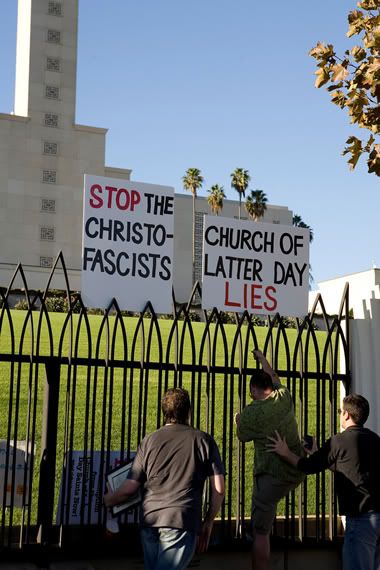 The fallout from the 2008 U.S. Presidential election continues. Proposition 8, the ballot initiative to end same-sex marriage in CA, passed by a very narrow margin. A number of voter groups voted overwhelmingly for this measure. This includes both Latino and African-American populations who turned out by a large measure also to vote for Senator Obama's Democratic candidacy. But the passing of Prop. 8 has not ended the issue of same-sex marriage--rather it has inflamed the Lesbigay community in CA and nationwide. In particular the LDS (Mormon) Church has drawn their ire. Some supporters of Prop. 8 thought their battle was over, but like the Lesbigay community after the May 15th Supreme Court of CA decision, it may still be just beginning.
The fallout from the 2008 U.S. Presidential election continues. Proposition 8, the ballot initiative to end same-sex marriage in CA, passed by a very narrow margin. A number of voter groups voted overwhelmingly for this measure. This includes both Latino and African-American populations who turned out by a large measure also to vote for Senator Obama's Democratic candidacy. But the passing of Prop. 8 has not ended the issue of same-sex marriage--rather it has inflamed the Lesbigay community in CA and nationwide. In particular the LDS (Mormon) Church has drawn their ire. Some supporters of Prop. 8 thought their battle was over, but like the Lesbigay community after the May 15th Supreme Court of CA decision, it may still be just beginning.Some background is necessary here. The LDS Church is a 19th century new religious movement based on a Restorationist view of the Christian church. Founded by Joseph Smith, the LDS Church for a time permitted and encouraged plural marriage, specifically the practice of polygyny. The Church was hounded from various places in the East and Joseph Smith himself was killed by an angry lynch mob. Settling in Utah territory, the LDS originally wished to set up its own kingdom, Deseret, but this was not compatible with U.S. visions of Manifest Destiny. After fighting U.S. troops and challenging the government, the LDS Church finally backed down and Utah was admitted as a U.S. state in the late 19th century. This did not stop the public view of Mormons from being very skeptical, and especially the view from Protestant Christians. Different members of Congress were elected to serve from Utah, and sometimes refused a seat by fellow members of Congress, based on their status as a Mormon or a holdover polygynist.
During this election season, the LDS Church, which has comparartively very few members in CA, nonetheless remained the main monetary donor base for the drive to outlaw same-sex marriage. Moreover, many LDS members donated their time and effort to spread the word about the campaign. Allegedly deceptive TV ads were also financed and shown, with major funding attributed to religious advocacy organizations but traceable to the LDS Church, among other sources.
Thus, the LDS Church and its members have now become a main target for the backlash against Prop. 8's passage, both in terms of boycotting, picketing, and sometimes violence. This was prefigured in anti-LDS ads shown before the election.
Since the passage, a number of Prop 8. donors have been targeted for protest. Scott Eckern, director of California Musical Theatre, had to resign his position after being exposed as a donor. Several Mormons have expressed frustration at being targeted, given their history. Likewise, defenders of same-sex marriage see the Utah-based out of state Church as taking away their civil rights, and therefore a legitimate target. Not to mention that the Church, as a 501c3 tax-exempt organization, is supposed to keep its political involvement to a minimum. Vandalism appears to have been on the rise as well.
It is important to mention that the LDS's support of Prop.8 takes place about 30 years after its campaign against the Equal Rights Amendment. And that not all Christian denominations are against same-sex marriage, or the ERA. There are number of reasons the LDS Church may have gotten involved here. Perhaps, after their Presidential candidate got snubbed on Super Tuesday by Mike Huckabee, they wanted to prove their cultural war bonafides, so as to ingratiate themselves among reactionary evangelical Protestants. Perhaps it was a more general way to distance themselves from their polygynist past. Perhaps California's location in the west seemed a bit to close to Deseret, the new Zion, for comfort. For whatever reason, the Lesbigay community, with its quiet patient activists and its radicals alike, seems to be taking this moment to punish them, and is willing to draw upon the cultural baggage that Mormonism carries in order to do so.
We'll have to see what happens. Imagine the racial fury that would accompany an Amendment telling black or latino people they could not longer marry each other, and you have some idea of the outrage. Given the animosity between the gay community and the Religious Right that has existed for years, it seems that there may be a cultural weak point for the Mormons. Just as the "No on Prop 8" detractors underestimated the LDS Church organization and financial capacity, the LDS Church may have underestimated what they have unleashed.











.jpg)

